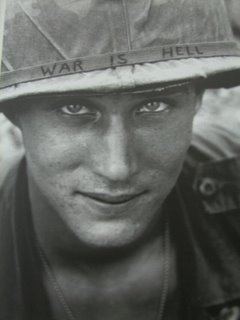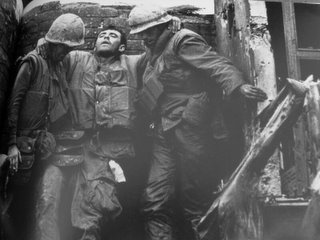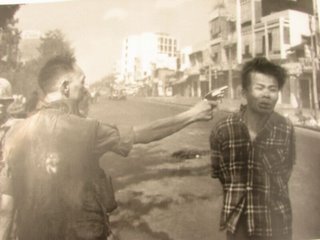Shooting Under Fire

The book is a compilation of works by famous war photographers which showcases some of the works by renowned photographers,basically depicting war in its utmost brutality.Some of the heart rendering pictures make u wonder- man what is it that we complain about? damn there are ppl suffering , dying while we from the comfort of our cosy homes complain abt almost everything. One reason why i came up with this article was that i was deeply touched and moved by the plight of people suffering and i wanted people to see what it isall about.

reminds me of the quote by William Sherman which goes like
"I am tired and sick of war. Its glory is all moonshine. It is only those who have neither fired a shot nor heard the shrieks and groans of the wounded who cry aloud for blood, for vengeance, for desolation. War is hell. "
had scanned some pics from the book which i'm sharing. I guess you have to see it for yourself
what war is all about.The description below each pic is by the person who photographed it.
About the graphic nature of photographs, i would just like to reiterate what Harold evans(former editor of Times) has to say-" No action can be moral if we close our eyes to its consequences". West of Saigon,1968
West of Saigon,1968
Sympathy for the enemy
These GI's had captured a vietcong fighter, only to discover that his belly had been blown out. Inspite of this he had been fighting for 2 or 3 days. The GI on the left said," Anybody who can fight like this for three days can drink out of my canteen any time. Years later this scene was enacted in Apocalypse now . Photo Credit: Philip Jones Griffiths

The Pearl Earring
One of the most moving photographs of the Vietnam War is of a priest giving last right to photographer Dickey Chapelle, who has stepped on a land mine. Her hair has fallen away from her face to reveal a pearl earring. Although she covered combat in the same dirt and sweat covered fatigues as her male colleagues,this touch of feminine adornment brings an immense poignancy to the picture of the dying woman .
 Tet offensive,Hue,1968 By Don McCullin
Tet offensive,Hue,1968 By Don McCullin
Dead Soldiers can't speak
I arranged the composition of this picture. I saw two soldiers plundering the body for souvenirs.They kept laughing at the photographs in his wallet and throwing them on the ground and calling him gook this and gook that and motherfucker,and then they wandered off. I watched them leave and i thought,this is'nt right.Here was a young boy with a bullet through his mouth that had busted teh whole of the back of his skull out, and he's lying in the rain. He had a picture of his mother and a young woman,a sister or daughter,and his little first -aid tin,which would hardlly suffic for any bullet wound,let alone one in the head.
I've never denied the fact that i arranged the photo. I felt i was making a statement on behalf of this boy. Dead soldiers cant speak anymore, but i can speak for them. I did'nt think that what i did was a crime or taking a big liberty. I wanted to show compassion for this man's sacrifice for his country
 Biafra,1968 By Don McCullin
Biafra,1968 By Don McCullin
To Biafra on the Ammunition Plane
The difficulty of photogrphing scenes like this is that it calls into question your commitement.What can i achieve by taking pictures of starving children?hat kind of risk am i taking here?What am i giving back here? i'm taking,but i' not giving.ifyou photograph a person who's dying, you're not going to save that person's life,and you start having all these things go through your head that could wind up sending you mad.I took a photograph of an albino boy there.I photographed him and just walked away,but he followed me and held on to my hand. Every time i'm in the darkroom and that image comes up through the developer,it's a haunting experience.I rarely print that picture. That boy and many people in those images did not survive,and you say,How can i justify this? but how can i not do it? you are trapped in a no-win situation.You want to go out thaere and bring attention to whats happening so that others might be saved.but you're not going t save that boy,so whatever your achievements are, however small or large they may be, you still walk away with a slight crime on your hands.
 By Christopher Morris
By Christopher Morris
The Tears Of Sarajevo
This picture was taken early on in yugoslavia. The boy is crying over the death of his father. it was almost as if the country was crying. It expressed the anguish of the whole country. There was something about the boy that remindede me of myself as a child. We have very similiar features. It was as if i became one with the boy in the photo, and it made me weep. I wept over all the death i had seen. i dont really cry much over the fighters who die, but i do for the civilian casualities and the horrendous wounds that weapons do to teh human body. people dont realise how horrific war is. i used to really get into my pictures, but after that point in sarajevo, i just stopped. i havent gone through any returns since 1990. i don'nt even want to look at them


This picture was simply captioned Farley Gives Way in the Life layout." Its not easy to photograph a pilot dying in a friends arms and later to photograph the breakdown of the friend," Burrows said." I did'nt know what to do. Was i merely capitalizing on someone else's grief".
 By Ron Haviv
By Ron HavivThe Eyes of Dying Men

Dying chechen,Grozny 1995

Where is the blood of war
 Hue 1968, By Philip Jones Griffiths
Hue 1968, By Philip Jones Griffiths






5 Comments:
War is quite a useless way of ending your life.
For people who decide as to who goes to war, against whom, and when -- it's usually a question of poer play and one-upmanship. And for the poor folks who actually fight and get killed in these wars-- if it's out of choice (as in they are not recruited forcibly to fight a war) - then the one's who go willingly are fairly delusional. Why would anyone gladly go to kill and get killed? a) because they are suicidal or b) they are delusional. if we take that option b) is more common than option a)-- then we can thank our popular media - films, news coverage, ads, etc.. - for representation of fighting in wars as 'brave' and 'macho'. Anyways, as long as "Might is Right" holds true and peoples obsession with being self-righteous and 'Right' stays--war will stay in our midst.
Hey,
Really interesting but also very sad at the same time. This reminds me of a documentary i once saw about the nazi holocaust!! I can never forget those images and I think that was the most shameful human act ever!
Nice blog, by the way.. keep it up :)
- Pallavi
i have to agreeee with u rajani.
politicians always get away with rhetorics- we'll give them a bloody nose n blah blah. man what do those bunch of idiots know?
ya i think the holocaust was one of the darkest chapters of human history.
thanxx pallavi-more will follow soon...
a quote which is apt for my previous comment
"When the first bullet goes past your head politics and all that shit go right out of the window"
@rajani
i dont thnk we can generalise abt the delusional part. it's got more to do with duty,honour,sacrifice
ha ha am i getting jingoistic
thgh no doubt in the name of honour,sacrifice worst of crimes , genocides have taken place
Post a Comment
<< Home